
Ever wake up from a dream feeling profoundly moved or unsettled, even without understanding why? You might be encountering archetypal dreams – powerful messages from your subconscious, tapping into a wellspring of shared human experiences. This guide will empower you to decipher these messages, using the insights of Jungian psychology to unlock your dream's hidden wisdom. We'll explore common dream symbols, provide a step-by-step process for dream analysis, and build your confidence in interpreting your own dreams. Prepare for an incredible journey of self-discovery.
Understanding Archetypes: Keys to Your Dream's Language
Archetypes, according to Carl Jung, are universal, symbolic patterns residing in the collective unconscious – a vast, shared reservoir of human experiences and symbols passed down through generations. Think of them as fundamental building blocks of the human psyche, recurring character types or symbols appearing across cultures and throughout history, even in your dreams! Your personal experiences color how these universal archetypes manifest in your dreams, making them uniquely yours while still echoing universal themes.
Common Archetypal Figures in Dreams
Let's explore some common archetypal figures frequently found in dreams:
The Self: Your ultimate potential, your integrated self. In dreams, it might appear as a radiant being, a guiding light, embodying wholeness and unity.
The Shadow: The darker side, the parts of yourself you may repress or hide. It's not inherently "bad," but represents unacknowledged aspects – fears, insecurities, imperfections. In dreams, it might manifest as a villain, a menacing figure, or anything unsettling. Confronting your Shadow is crucial for growth.
The Anima/Animus: The feminine aspects within a man (Anima) and the masculine aspects within a woman (Animus). These influence how we relate to ourselves and the opposite sex. In dreams, they often appear as significant romantic figures, reflecting aspects of yourself you might not fully embrace.
The Persona: Your public mask, the role you play for others. Dreams featuring your Persona might show you acting a role instead of being yourself.
Beyond these, many other archetypes exist, each with unique symbolic meaning. You might encounter the Wise Old Man or Woman (offering guidance), the Great Mother (representing nurturing), or the Trickster (embodying chaos and unexpected change). Do you ever wonder, What recurring symbols have I encountered in my own dreams?
Decoding Your Dreams: A Practical, Step-by-Step Guide
Ready to explore your subconscious world? This is a journey, not a race. Take your time.
Step 1: Dream Journaling – Your Nightly Record: Keep a notebook by your bed. Immediately upon waking, write down everything you remember – even seemingly insignificant details. The more you capture, the richer your analysis. Isn't it fascinating how much you can unlock on reflection?
Step 2: Identifying Recurring Patterns – The Clues: After a few days or weeks, review your entries. What images, symbols, characters, emotions, or feelings stand out? Repeated symbols are particularly significant, highlighting key aspects of your unconscious. What recurring symbols or themes consistently appear in your dreams?
Step 3: Connecting the Dots – Recognizing Archetypes: Connect your recurring symbols to the archetypes discussed. Is that shadowy figure representing a repressed fear? Does water symbolize your emotional depths? Remember, interpretations are deeply personal.
Step 4: Personal Reflection – The Core of the Matter: This is where the true work begins. How do these archetypes relate to your current life? What aspects of your personality are they reflecting? What might your dream be suggesting you should do?
Step 5: Embracing Ambiguity – Your Unique Journey: There are no right or wrong answers. Dream analysis is subjective; the goal is to develop a deeper understanding of yourself. Remember, What unique insights has this process already offered you?
Example: Unmasking the Shadow
Imagine repeatedly dreaming of being pursued by a faceless figure. Instead of immediate conclusions, ask: What aspects of myself am I avoiding? What fears am I repressing? The shadowy figure might represent these hidden aspects, challenging you to confront and integrate them. This kind of self-reflection can be very enriching.
The Ongoing Journey
Analyzing archetypal dreams is a lifelong journey, a process of continuous exploration, revealing more questions than answers. The unconscious is a vast and mysterious realm; be patient. Your dreams hold keys to personal growth and transformation, so let them guide you.
How to Interpret Recurring Dream Symbols Using Jungian Archetypes
Key Takeaways:
- Recurring symbols often hold significant personal meaning, reflecting unconscious processes.
- Jungian psychology offers a framework for understanding these symbols through archetypes.
- Identifying recurring symbols, exploring personal associations, and considering universal archetypes are crucial.
- Self-reflection and journaling enhance the dream analysis process.
- Integrating insights from dream analysis fosters self-awareness and personal growth. How might you integrate today's insights into your waking life?
A Step-by-Step Guide
- Maintain a dream journal: Record dreams immediately upon waking.
- Identify recurring symbols: Look for repeated images, feelings, or situations.
- Associate with archetypes: Connect symbols to Jungian archetypes (e.g., Shadow, Hero, Anima/Animus).
- Explore personal connections: Consider your emotions and memories linked to the symbol.
- Integrate insights: Reflect on the dream's message and its relevance to your waking life.